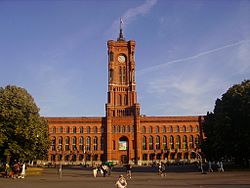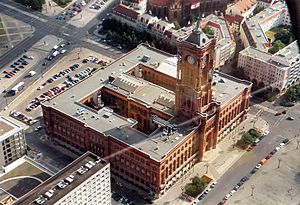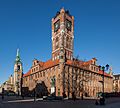Rotes Rathaus facts for kids
Quick facts for kids Rotes Rathaus |
|
|---|---|

Rotes Rathaus (Red City Hall) of Berlin
|
|
| General information | |
| Type | City hall |
| Architectural style | Renaissance Revival |
| Location | Berlin, Germany |
| Coordinates | 52°31′07″N 13°24′30″E / 52.51861°N 13.40833°E |
| Construction started | 1861 |
| Completed | 1869 |
| Design and construction | |
| Architect | Hermann Friedrich Waesemann |
The Red City Hall (called Rotes Rathaus in German) is the main city hall of Berlin, Germany. It is located in the Mitte area, close to Alexanderplatz. This important building is where the governing mayor and the city government (the Senate of Berlin) work. It got its name "Red City Hall" because it is covered with red bricks.
History of the Red City Hall

The Red City Hall was built between 1861 and 1869. The architect was Hermann Friedrich Waesemann. He designed it in a style called Renaissance Revival. This style was popular in northern Italy a long time ago.
The building looks a bit like the Old Town Hall in Toruń, which is now in Poland. The tower of the Red City Hall also reminds people of the cathedral tower of Notre-Dame of Laon in France. Before this building, there were several older buildings from the Middle Ages on this spot. The Red City Hall now takes up a whole city block.
During World War II, the building was badly damaged by bombs. It was rebuilt between 1951 and 1956. The builders made sure it looked just like the original plans.
After the war, Berlin was divided into different parts. The Red City Hall was in the part controlled by the Soviet Union, which became East Berlin. It served as the city hall for East Berlin. Meanwhile, the Rathaus Schöneberg was the city hall for West Berlin.
When Germany became one country again, the government of the reunited Berlin moved back into the Red City Hall. This happened on October 1, 1991.
Related pages
Images for kids
-
Seen from the Fernsehturm
-
Toruń town hall, inspiration for the Rotes Rathaus
See also
 In Spanish: Ayuntamiento Rojo para niños
In Spanish: Ayuntamiento Rojo para niños







